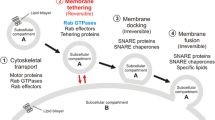Abstract
The human novel gene pp5644 (GeneBank Accession No. AF289559) coding for 124 amino acids was recently cloned. Overexpression of pp5644 in Hela cells significantly inhibited the growth and colony formation. The pp5644-interacting protein FAPP1 (phosphatidylinositol-four-phosphate adaptor protein1) associated protein-1, called FASP1, was obtained by using yeast two-hybrid system. The interaction between pp5644 and FASP1 was experimentally confirmed by GST pull-down assay In vitro and co-immunoprecipitation assay in vivo. Co-localization of pp5644 and FASP1 in cytoplasm in Hela cells could further support the interaction. Based on the experimental results, it is suggested that pp5644 physically bind to FASP1 and the biological significance of this kind of interaction in vivo is discussed. (Mol Cell Biochem 271: 151–158, 2005)
Similar content being viewed by others
References
Martin TF: Phosphoinositide lipids as signaling molecules: Common themes for fignal transduction, cytoskeletal regulation, and membrane trafficking. Annu Rev Cell Dev Biol 14: 231–264, 1998
Toker A: Phosphoinositides and signal transduction. Cell Mol Life Sci 59(5): 761–779, 2002
Leevers SJ, Vanhaesebroeck B, Waterfield MD: Signaling through phosphoinositide 3-kinases: The lipids take center stage. Curr Opin Cell Biol 11: 219–225, 2002
Balla T: Pharmacology of phosphoinositides, regulators of multiple cellular functions. Curr Pharm Des 7(6): 475–507, 2001
Martelli AM, Tabellini G, Borgatti P, Bortul R, Capitani S, Neri LM: Nuclear lipids: New functions for old molecules? J Cell Biochem 88(3): 455–461, 2003
Mueller-Roeber B, Pical C: Inositol phospholipid metabolism in arabidopsis characterized and putative isoforms of inositol phospholipid kinase and phosphoinositide-specific phospholipase C. Plant Physiol 130: 22–46, 2002
Berridge MJ, Irvine RF: Inositol phosphates and cell signaling. Nature 341: 197–205, 1989
Nishizuka Y: Intracellular signaling by hydrolysis of phospholipids and activation of protein kinase C. Science 258: 607–614, 1992
Clarke JH, Letcher AJ, D’Santos CS, Halstead JH, Irvine RF, Divecha N: Inositol lipids are regulated during cell cycle progression in the nuclei of murine erythroleukaemia cells. Biochem J 357: 905–910, 2001
De Matteis MA, Godi A, Corda D: Phosphoinositides and the Golgi complex. Curr Opin Cell Biol 14: 434–447, 2002
Tolias KF, Cantley LC: Pathways for phosphoinositide synthesis. Chem Phys Lipids 98(1–2): 69–77, 1999
Toker A: The synethesis and cellular roles of phosphatidylinositol 4,5-biophosphate. Curr Opin Cell Biol 10: 254–261, 1998
Yu H, Fukami K, Watanabe Y, Ozaki C, Takenawa T: Phosphatidylinositol 4, 5-bisphophate reverses the inhibition of RNA transcription caused by histone H1. Eur J Biochem 251(1–2): 281–287, 1998
Wang XY, Li ZL: The new development of B cell activating signaling pathways. Foreign Medical Sciences: Section of Immunology 19(6): 93–296, 1996
Dowler S, Currie RA, Campbell DG, DEAK M, Kular G, Downes CP, Alessi DR: Identification of pleckstrin-homology-domain-containing proteins with novel phosphoinositide-binding specificities. Biochem J 351: 19–31, 2000
Payrastre B, Missy K, Giuriato S, Bodin S, Plantavid M, Gratacap M: Phosphoinositides: Key players in cell signaling, in time and space. Cell Signal. 13(6): 377–387, 2001
Roth MG: Phosphoinositides in constitutive membrane traffic. Physiol Rev 84(3): 699–730, 2004
Stevenson-Paulik J, Love J, Boss WF: Differential regulation of two arabidopsis type III phosphatidylinositol 4- kinase isoforms, a regulatory role for the pleckstrin homology domain. Plant Physiol 132(2): 1053–1064, 2003
Jung JY, Kim YW, Kwak JM, hwang JU, Young J, Schroeder JI, Hwang I, et al.: Phosphatidylinositol 3- and 4-phosphate are required for normal stormatal movements. The Plant Cell 14: 2399–2412, 2002
Author information
Authors and Affiliations
Corresponding author
Rights and permissions
About this article
Cite this article
Ye, XX., Lu, H., Yu, Y. et al. pp5644 Interacts with phosphatidylinositol-4-phosphate adaptor protein-1 associated protein-1. Mol Cell Biochem 271, 151–158 (2005). https://doi.org/10.1007/s11010-005-5907-6
Received:
Accepted:
Issue Date:
DOI: https://doi.org/10.1007/s11010-005-5907-6




